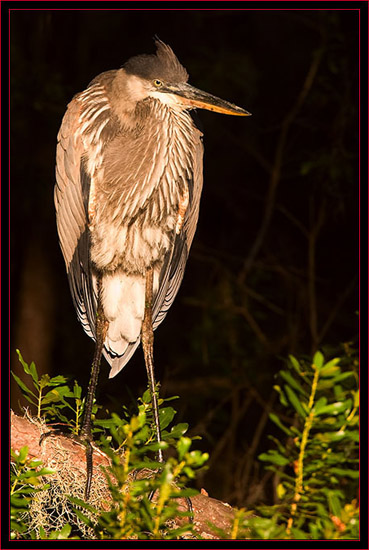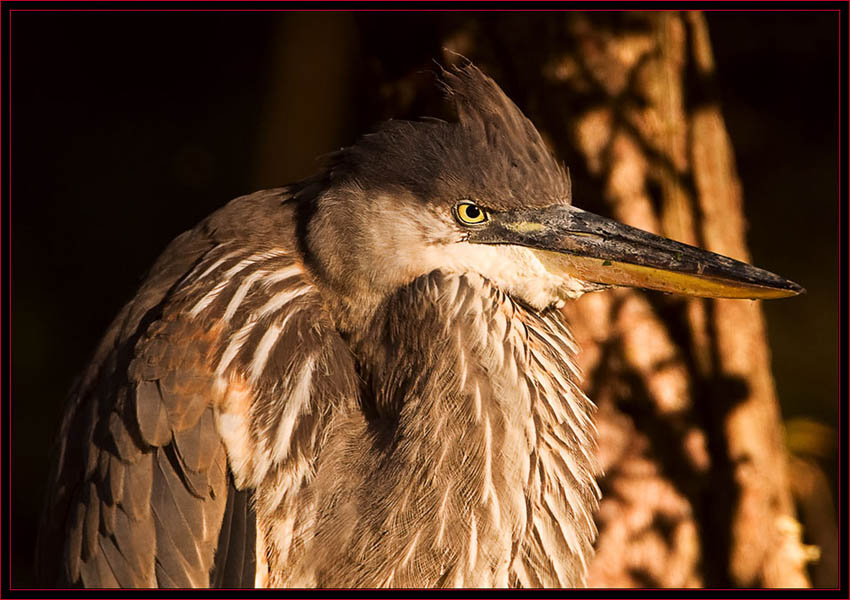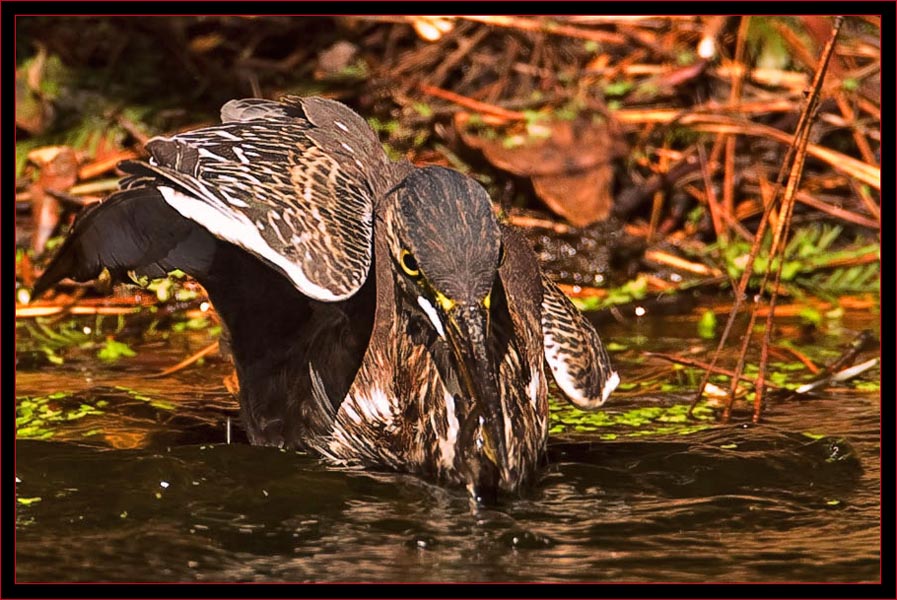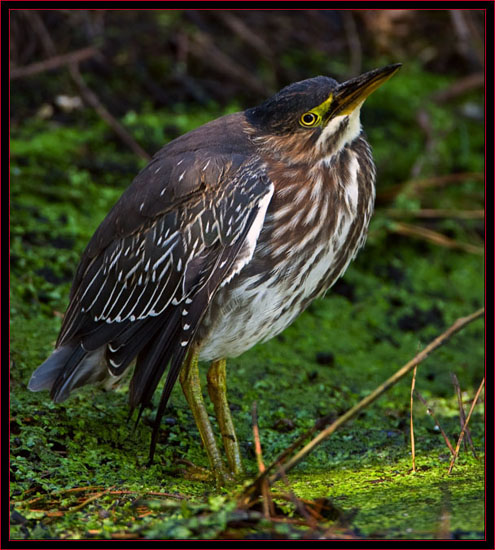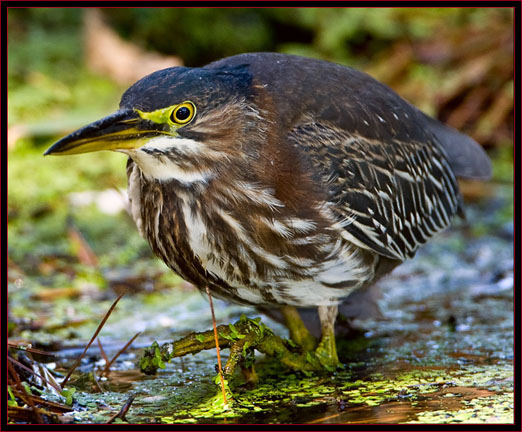
|
October/November 2007
Some Background Information
Just before I left Maine Iíd ordered one of the new Canon EOS 1D Mark III cameras. Unfortunately, I had only a weekend to decide to keep or return the camera. In the end result, I returned it as I was concerned with focus issues as this problem was directly realted to what's required in the realm of bird photography. If I determined the camera experienced this problem, some bodies did, others didnít apparently, I still would have had the Canon warranty but thought it was just too expensive a purchase to take the risk. My weekend with the camera indicated some surprising resultsÖ The bird wing images I took were quite good in my estimation Ė supposedly the cameraís weak point. However, some of the more or less static shots with the 1D Mark III on my 500mm lens tripod mounted did not meet my expectations. Ken Schmidt, a friend, fellow astronomer and bird imager, had owned and returned two of these bodies. Using the information gleaned from he and others helped guide my decision. I retained the test shots and intend as time permits, to write an article about my findings.
|
I still wished to purchase another camera. I was pleased to learn that a new order of Canon EOS 40d
bodies had been delivered to the marketplace and I was able to obtain one in time for my trip south.
Whatever time I found to take the field in the coming weeks would allow an opportunity to test this camera.
|
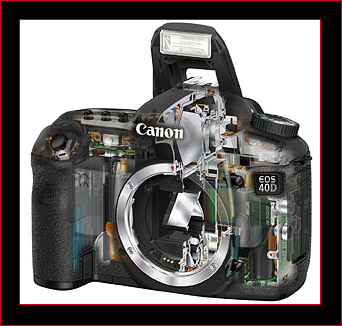
|

|

|
Iíd been made aware through a ĎBirds as Art Bulletiní
from Arte Morris about a DeSoto Weekend Workshop pursuant to bird/nature photography to be held in North Tampa, Florida and Fort DeSoto Park, October 20th-21st. This was a workshop with James Shadle
a terrific nature photographer. Sensing an opportunity to learn something and to take the field with some other photographers, I made some inquiries and ended up signing up for the event. I planned my arrival
in Georgia accordingly and after a few days at work getting up to speed, planned to drive into the Tampa area to do some imaging.
I contacted, Ken Schmidt, who lives in the Orlando area to let him know Iíd be in state. His schedule precluded attending the seminar but he said he had time to meet so we could image together in Fort DeSoto Park. This worked out great and the morning before the seminar commenced, Ken and I hooked up. Iím glad we did as this was the most productive of the hours I spent in the area. If youíre interested in viewing a great collection of photographs I urge you to investigate Kenís Gallery. Heís an interesting fellow and it shows... |
Saturday October 20th - Fort DeSoto ParkKen and I met in the parking area by the Ranger Station in the dark. Sunrise wasnít all that early this far south and it was before the daylight savings time change. It was great to see him as it had been awhileÖ Weíd crossed paths often over the years while set up to do astrophotography sessions and became friends with our common endeavors. He is an able bird imager and we had much to discuss about this pursuit and friends we shared while waiting for the sun to rise. Another plus was Ken had imaged regularly in this park. He indicated many photographers and birders view this area as one of Floridaís premier spots and expected it may get crowded except for the fact it didnít appear to be a nice day in the making. He was correct about the weather, it had been raining leading up to the weekend and although we didnít have this to contend with, it remained overcast all day. Short-billed Dowitchers, imaged with the Canon EOS 40D handheld 1/800 second, ISO 400, 400mm at f5.6.
|

|

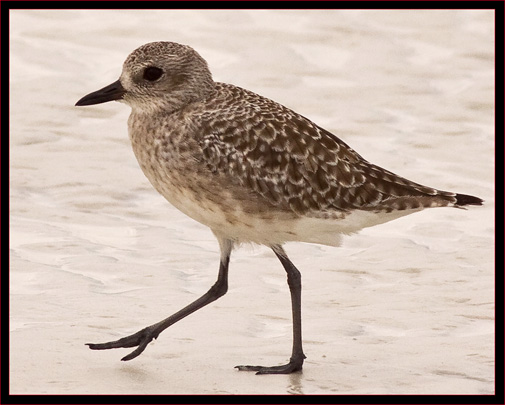
|
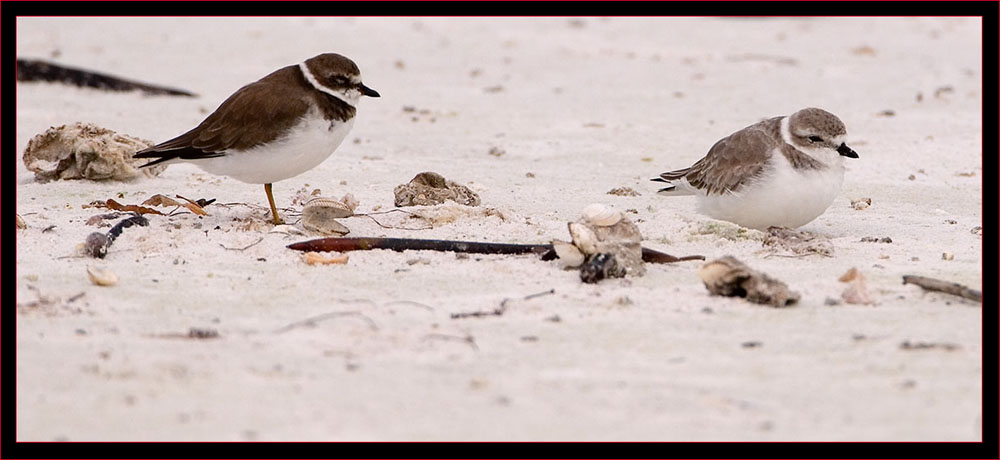
|
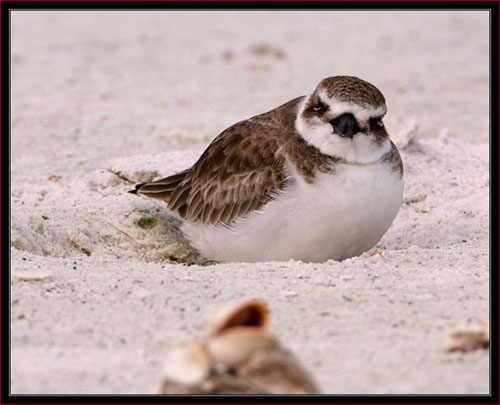
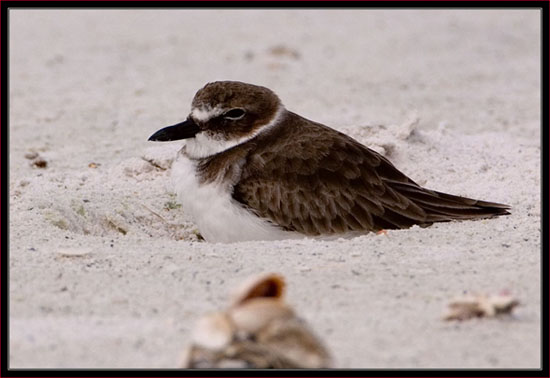
|


|

|
Ken and I drove our vehicles back to the main parking lot to walk into the beach. We could see a major flock of birds and even from a distance could see Black Skimmers,
Brown Pelicans, Royal Terns
and a plethora of gulls. Some of the beach remained cordoned off due to the plover nesting season although it appeared late in the year for this. We kept our distance just in case and still found many subjects
worth investigating. I could see this would be an interesting morning.
Flight of Royal Terns with some Sandwich Terns mixed in. imaged with the Canon EOS 40D handheld 1/400 second, ISO 400, 400mm at f/7. |

|
|
Every now and then the flock would get spooked and fly around the circuit landing pretty much in the same spot theyíd just exited. They all appeared quite social seeing how the group was a
diverse mix of species. This behavior can often make you wonder as at times all the birds in the area will fly indicating a perceived threat, at other times half or just a small group will take flight while the
balance act like everything is fine.
We talked with a fairly large group of birders out with some local Audubon experts. At first we thought it would be best to avoid these folks rather than disturb their observing but as we neared it became apparent they were quite interested in speaking with us. Some were particularly intrigued with our camera gear and asked about equipment choices, our evaluation of lenses and camera brands. It was an interesting time and we found some of these people to be exceedingly knowledgeable. Although in some cases quite distant, they pointed out some species I wasnít readily familiar with. We had a good discussion with some nice folks. Black Skimmers and terns is flight. Imaged with the Canon EOS 40D handheld, 1/1250 second, ISO 400, 400mm at f/5.6.
|

|
A Few More from Saturday
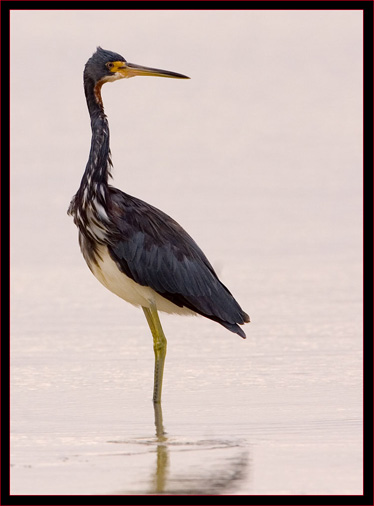
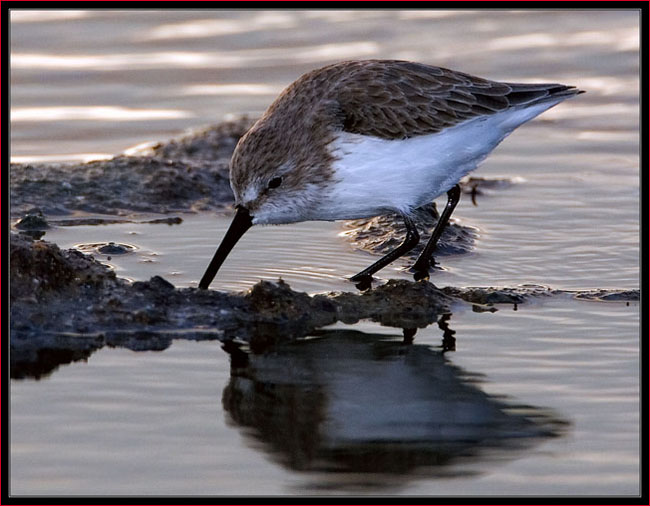
|

|


|

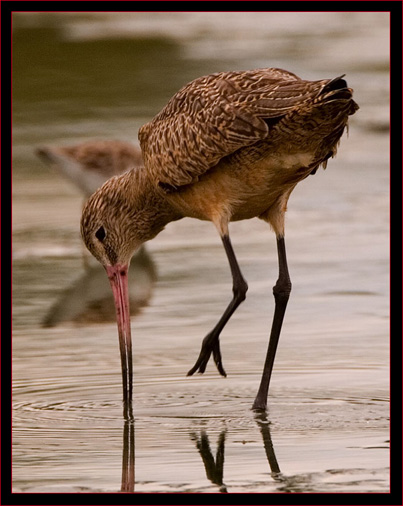
|

|
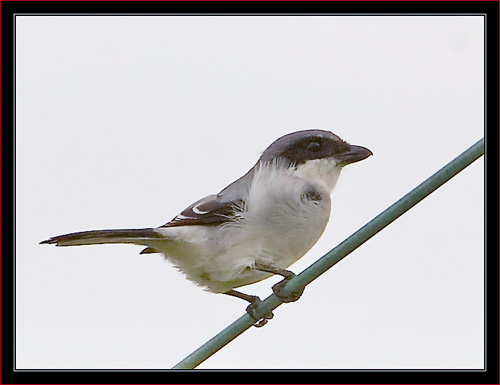
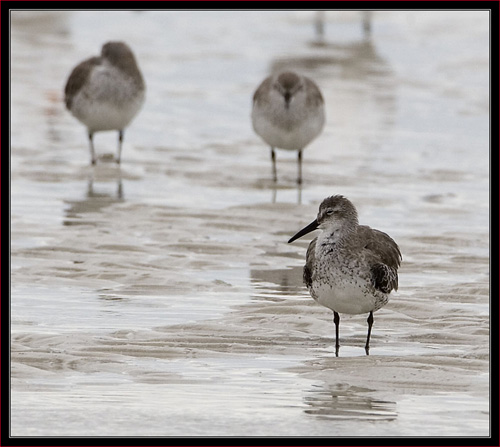
|

|

|
This was my first time shooting with the 40D and although I hadnít inspected any images except on the cameraís LCD screen I was impressed with it. The menus were reasonably the same as the 30D
but with some improvements. I felt comfortable with the camera in short order. While researching the camera Iíd read the autofocus for flight images had been improved and did take a few wing shots although in most cases
the day wouldnít have been deemed suitable with the weather conditions we had. However, I was in Florida, it was warm and I was out so made the best of it, plus I still had tomorrow in this
area. Once I downloaded and investigated the files on my laptop I thought this camera would work out just fineÖ
Little Blue Heron in flight taken with the Canon EOS 40D handheld, 1/1250 second, ISO 400, 400mm at f/5.6. |
|
The James Shadle classroom portion of the weekend was this evening and I wished to get back to the hotel for a time before I had to travel to
North Tampa Photography, the camera store where everyone was meeting.
When I did arrive the place was packed both in the parking lot and seating area for the talk - James managed a great turnout and the store was open for those of us in the group if anyone wished to make a purchase. They had the battery grip in stock for the 40D
and I purchased one as I already had spare batteries available. Part of the four-hour session was equipment related and many items for field use were discussed. The morning plan was to meet near daylight at the same spot
Iíd met Ken this morning. I was good with this as I knew where to go and looked forward to the session. It turned out the field day was well attended but I believe more people attended the lecture portion than took the field.
Ruddy Turnstone taken with the Canon EOS 40D handheld, 1/400 second, ISO 400, 400mm at f/8.
|

|
Sunday October 21st - Fort DeSoto Park
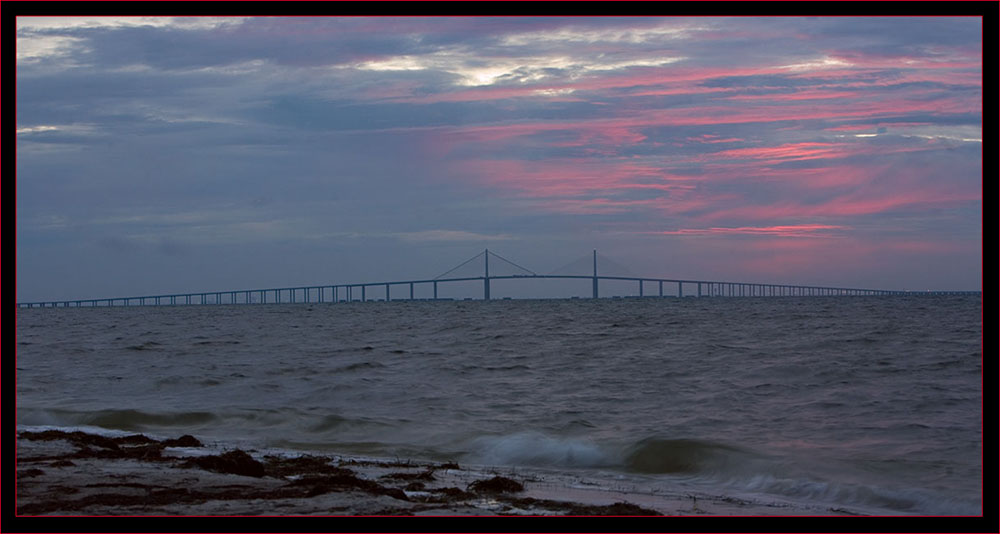
|
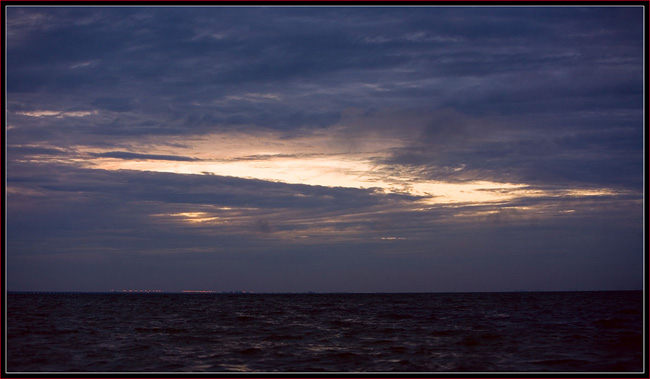
|
Iíd had several early mornings and last night was fairly late by the time I drove back to the hotel from North Tampa, but I was up early and ready to go. The park was about a half-hour drive and like yesterday this was done in darkness. James, ably aided by his son, also an excellent nature photographer, provided several options of things to do for the group as the sun rose. I elected to go to the beach with many others to image the sunrise and hopefully obtain some backlit bird images in the early light. I was hoping this morning would find better sky conditions than yesterday. It was better but far from pristine with cloud cover on the horizon. |
|
James did a good job briefing everyone and he made the rounds answering questions and offering advice. It was barely dawn and I had no idea what level photographically some of the others in
the group may have achieved as I looked around. For me this was like many other early mornings out with the cameras but with a lot more people around. Iíd carried the 500mm lens on the Wimberley
Sidekick & tripod out but once in the field changed to a 70-200 f/2.8L IS lens due to the lighting conditions and with few birds around. We were going to shoot seascapes as the sky conditions
precluded bird imaging against the rising sun pretty much Ė we werenít actually going to see the disk of the sun rising unless we experienced a break in the cloud coverÖ
Imaged with the Canon EOS 5D camera on tripod.
|
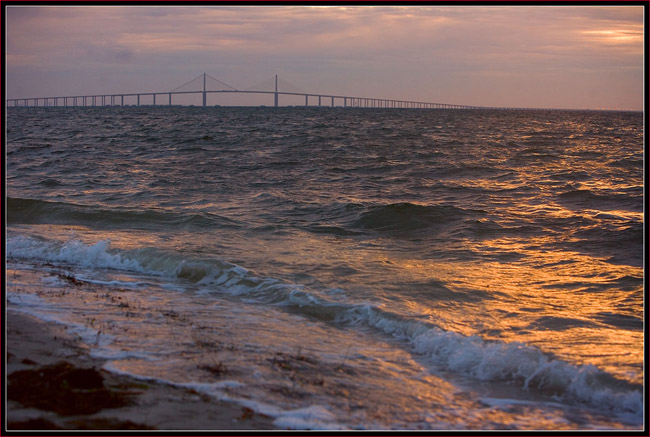
|

|
The day in the field consisted of a morning and afternoon session. You could attend one or both and the fee was structured accordingly. Iíd signed up for both sessions but ended up leaving during the long break between the two (this was nearly four-hours, which I hadnít realized) as I had to be in Savannah in the morning with multiple hours on the road before returning to the apartment. I was disdainful about leaving but the session went until sunset and I didnít wish to roll in after midnight for yet another early rising. |
|
I donít know how many people attended this field event but Iíd estimate around forty between what ended up being two sub-groups. One group was for folks that didnít have issue with
getting down low on the ground, possible getting wet and nasty. These were provided with skids that would slide along the sand with the cameras mounted so you could lie down. This is actually a
good technique because nobody views subjects from this angle and it can aid composition. I like to shoot from a low position at times but didnít have enough clothes with me to
wish to crawl around and get wet so compromised with lowering my tripod when so inclined. Most of the people in the group I was with had tripods so remained upright most of the time.
As I always carry a camera handheld itís a simple matter to plant the tripod to free my hands so I can kneel, sit or lay prone should I choose. I was utilizing my usual systems
for this session, the Canon 5D with the 500mm f/4L IS lens extended to 700mm on a tripod and the 40D with the 400 f/5.6L lens on a strap easily accessible for flight shots or anything elese that
caught my eye. The only difference was I used the 40D now in lieu of the 30D camera. I utilized the 40D often as I wished to evaulate the images and was testing how it performed.
White Ibis taken with the Canon EOS 40D handheld, 1/640 second, ISO 400, 400mm at f/5.6.
|
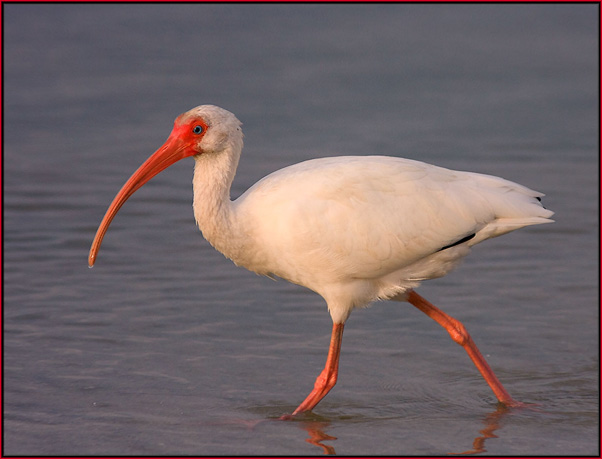
|

|
We didnít travel far at all and remained far less mobile than Ken and I did yesterday. James was trying to get people to concentrate on several waders nearby as he explained about bird
behavior to seek action shots. He was absolutely right about this but it can be a bit redundant. The end result was I had many shots that were repetitive. What was worse, the
Audubon group or some other camped out near the large flock we investigated yesterday and because we had so many in our group, James was reluctant to head that way so we didnít
disturb them. The Audubon group remained in this spot for several hours and thusly we stayed in the same general area we occupied for the entire morning, never approaching the largest group of
birds to be seen...
Snowy Egret imaged with the Canon EOS 5D camera on tripod, 1/160 second, ISO 400, 700mm at f/8. |
|
The sun broke the cloud cover and it became warm and sunny. Probably not Ďwarm & sunnyí by Florida standards Iím certain, but for me it was getting downright hot. There was a Reddish Egret foraging
in a body of water near us and James had our group jockeying for position to photograph this bird while fishing. I spent far longer than I ever would have with this task usually, but I got some
decent images of this bird. I donít recall how many exposures I took of this wader but it was significant. Iím displaying several of my favorite photographs of this egret here for review as the
bird went through the Ďfishing danceí they utilize. This series of shots were all done using the 40D handheld at 400mm & ISO 400.
Reddish Egret watching and waiting... Canon EOS 40D handheld, 1/800 second, ISO 400, 400mm at f/7.
|
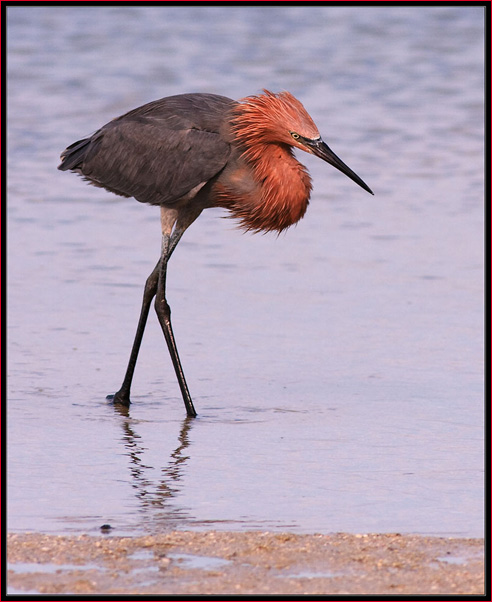
|

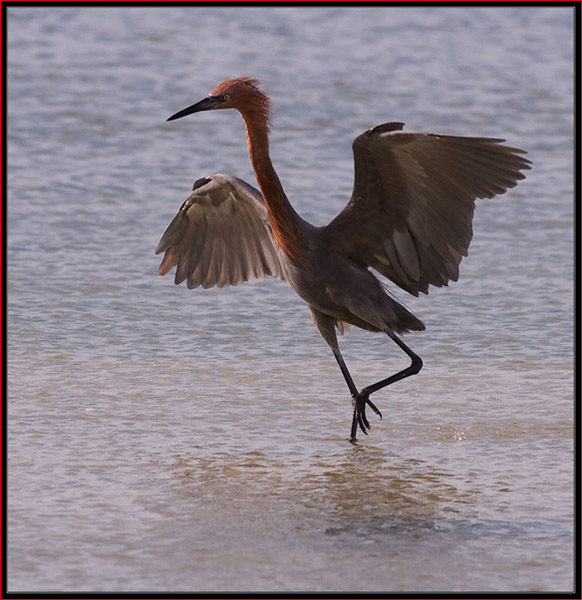
|
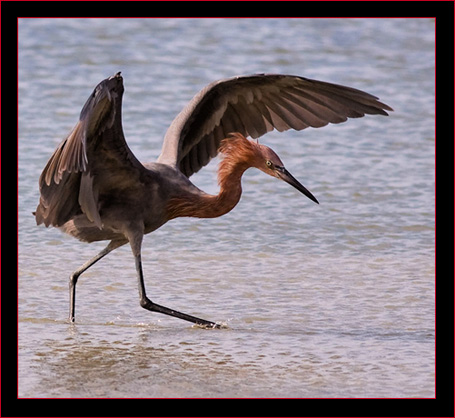

|
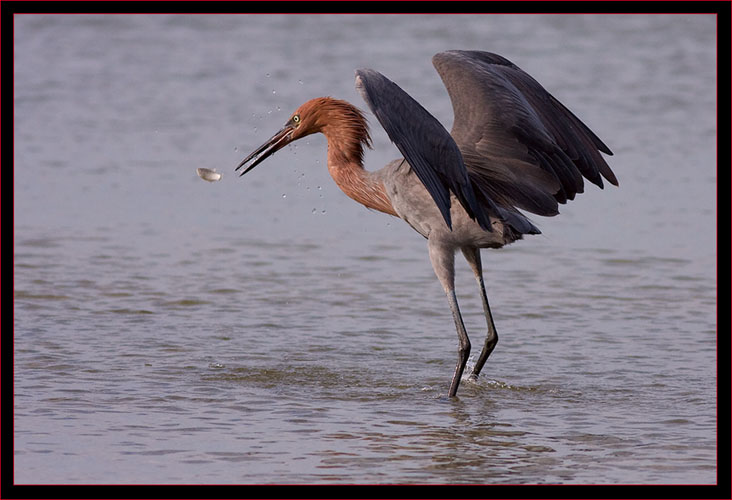
|
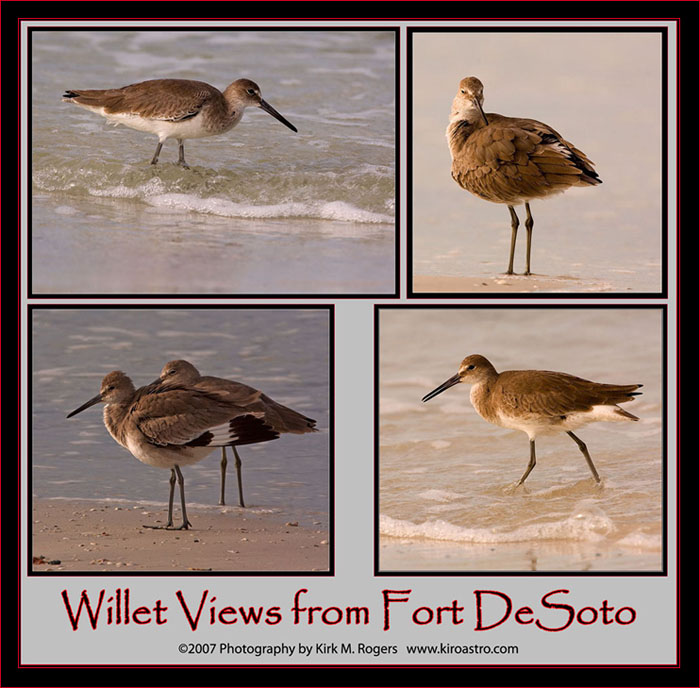
|
As I close this portion of 'Southern Photography' for the balance of time I spent at Fort DeSoto Park Iíll add a few more images from the morning. I wish to thank James Shadle and
North Tampa Photography for arranging the workshop - it was great! I also thank my compatriot Ken Schmidt for making the drive to meet me. I'd enjoyed it...
A Willet composite; photographs from along the water's edge as the birds foraged. |
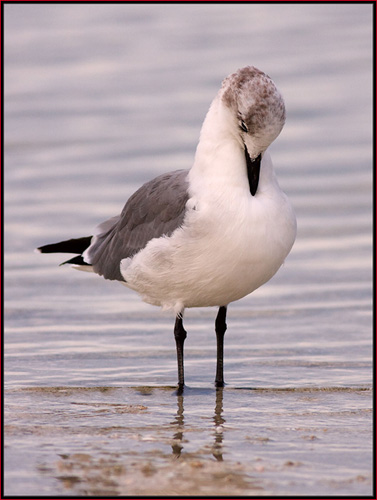

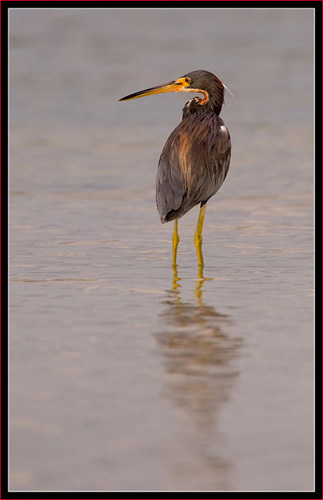
|
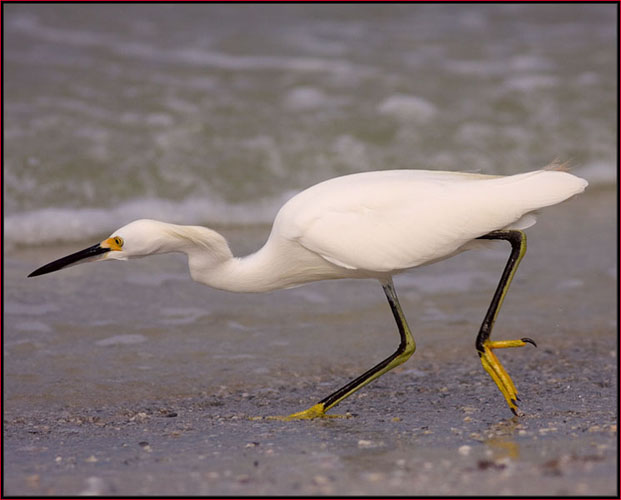
|
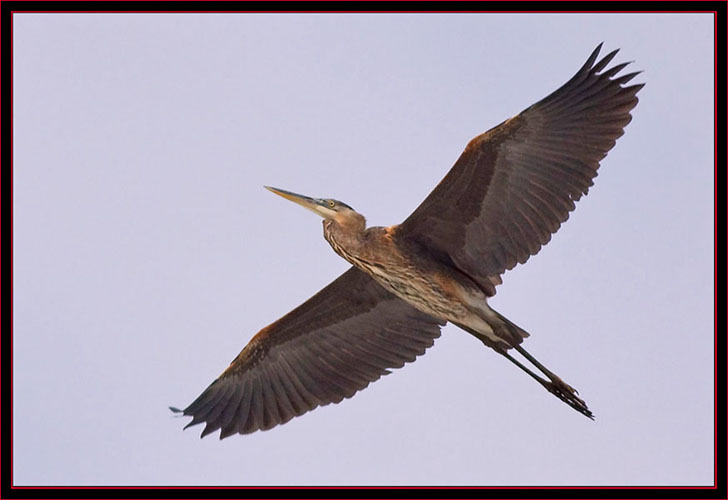
|
A Morning at Skidaway Island
I checked out three parts of Skidaway Island besides looking for whatever one may find near the road as you drive in. The first as mentioned was Priest Landing; next I drove nearby to the State Park as I wanted to see how active this environment may be this time of year. Lastly, I had to go into The Landings, a gated community where my friend Bill lives and drove around a few spots to see what may be occurring.
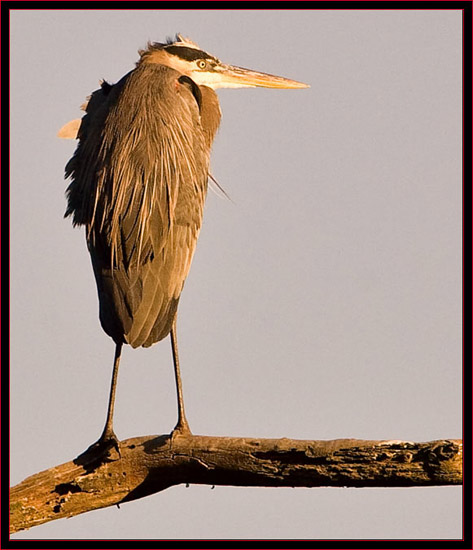
|
As I walked the path along the lagoon near the ocean at the landing I could see there was much less activity than in the summer months. There appeared to be
more smaller birds flitting about as opposed to waders and I tried to take some shots along the trail. Most of these didnít turn out well as it wasnít light
enough to support this effort, even with the flash.
As the sun started to break the horizon I got off the trail and walked down the road where several birds perched on the logs were being illuminated. Included with this group were several Great Blue Herons and some Wood Storks farther off in the distance. Great Blue Herons must be one of the most wide ranging and prolific of all the waders. I donít think Iíve traveled anywhere along the East Coast from Maine to Florida where these birds werenít present whether near salt/brackish water or inland on freshwater ponds and lakes. I certainly donít mind this as I enjoy viewing them, but from a birders prospective their like seeing an American Robin or similar common species. Great Blue Heron in morning light. Canon 5D tripod mounted 1/1250 second, ISO 400, 700mm at f/8. |

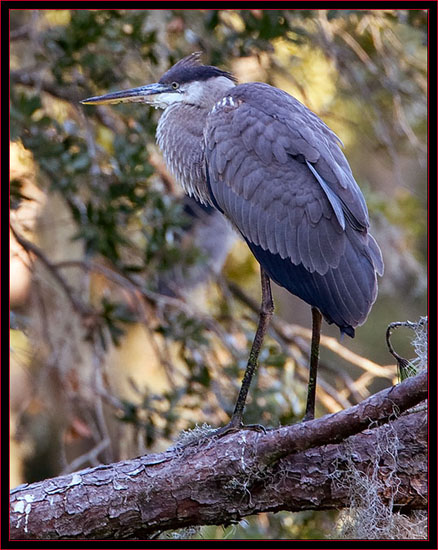
|
